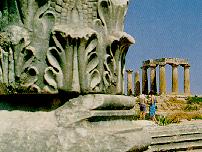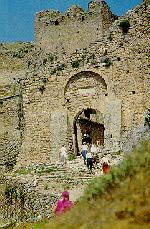| ITHACA |
![]() |
 |
This description provides information of ancient sites, seaside resorts, churches, monasteries, landscapes and small towns and villages. Additional details can be found in various books printed on Greece, such as the 'Blue Guide to Greece.' The names of places conform to the accented Greek pronounciation which would be the one a traveller would face upon a potential visit.
For a general map of the Ionian islands, click here!. For a map of the Ithaca island area, click here.
To go back to the Ionian islands main page, click here!
ITHAKA or ITHACA or ITHAKI
 |  |
Modern Greek ITH�KI, the second smallest of the seven main Ionian Islands, with an area of 37 square miles (96 square km), pop.3,646, it consists of two limestone masses connected by a narrow, hilly peninsula that curves to form the head of a gulf facing the Greek mainland. The island is separated from the island of Cephallenia to the west by the Ith�kis Channel, approximately 2.5 miles (4 km) in width. With little arable land, Ithaca must import grain, but some olive oil, wine, and currants are produced. Ith�ki (Vath�), the chief place and port of the island, is well protected at the head of a narrow, deep, horseshoe-shaped inlet of the gulf.
The island owes its fame almost solely to its classical associations, almost no mention of it appearing in writings of the Middle Ages. Although there have been some signs of ancient habitation, as late as AD 1504 it was almost uninhabited following depredations by corsairs, and the Venetians had to grant incentives to settlers from neighbouring islands and the mainland to repopulate it. Although its identity with the Ithaca of the legendary hero Odysseus has been disputed by scholars, the island appears to be described in the Odyssey with considerable coincidence of topographic detail. The Homeric "Fountain of Arethusa" has been identified with a copious spring rising at the foot of a sea cliff at the island's southeastern extremity, and counterparts have been sought for such Homeric locales as Mt. Neritos, Mt. Neion, the harbour of Phorcys, the town and palace of Odysseus, and the cave of the Naiads. Some authorities place the Homeric town on an inlet on the northwestern coast of the island, others at A�t�s on the isthmus. |
No amount of ingenuity, however, can fully reconcile the descriptions in the Odyssey with the present topography. It has been suggested that the Homeric Ithaca should be identified with Leucas and that the name may have been transferred through a migration of the inhabitants. Excavations by the British School at Athens at Polis, A�t�s, and elsewhere have confirmed occupation during the appropriate period, the Mycenaean, but nothing can be identified positively with Homeric localities. These same excavations revealed traces also of a Corinthian colony (c. 800 BC) at A�t�s.
Transport
By boat from Cephalonia and Patras.
Towns
Bathi is the lovely amphitheatric capital town at the end of a deep bay in the south side of the island. It has been identified as the ancient Forkis. On entering the bay you will encounter the little island of Lazareto with its little church and building which used to house a hospital and a prison. The town itself has an old venetian fort and offers many beautiful architectural features. It also has some ancient sites and a good archaelogical museum. Just 2km from the town you will find the famous cave of Nymfon where, according to legend, Odysseus hid the presents of the Faiakes on his return. Other ancient ruins have been unearthed nearby after Shleeman's 19th century excavations.
Agogi (16km)
On top of a mountain at 600m, this village offers spectacular views of the sea. It is well known for the nearby massive rock monoliths. Nearby there is the old Monastery of Kathara.
Stavros
A village in the north of the island which leads to the bay of Polis which, according to the excavations, is the site of the ancient Ithaca. There is a legend of a sunken town in the sea. The cave of Liozos is nearby where mycenean pottery have been found. Further 2nd milleneum BC findings have also been unearthed at Pelicata close to Stavros.
Exogi (22km)
The furthest and most spectacular view-wise mountain village of Ithaca. At the edge of the village you will find pyramidal tombs. The church of Santa Barbara has a wood carved temple.
Kioni (24km)
A traditional village with protected architectural colour and a lively marina and life. Very interesting and well worth visiting. It offers many nearby beautiful beaches.
Platrithia (17km)
A large, legend-filled village, at the northernmost part of the island, with beautiful natural beaches and green forests.
Lefki (13km)
At the western part of the island on the mountain overlooking Cephallonia and the narrow sea passage. It has lovely beaches at Ammoudaki, Lefko Yialo and Koutoupi.
Frikes (19km)
Close to Platrithia, a lovely tiny fishing hamlet of only 50 people but infinite calmness. A small marina is here as well as beckoning beaches at Korvoulia and Limenia.
Perahori (2km)
Just south of Vathi, with a very interesting Byzantine church and the monastery of Taxierhes in a beautiful setting.
Hani
At the narrowest part of the island, with fantastic views to both sides of the island. The Monastery of Kathariotissas (1693) is nearby.
| |





